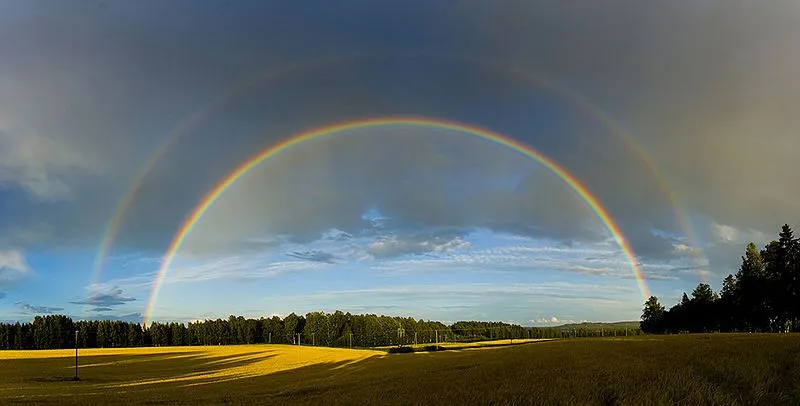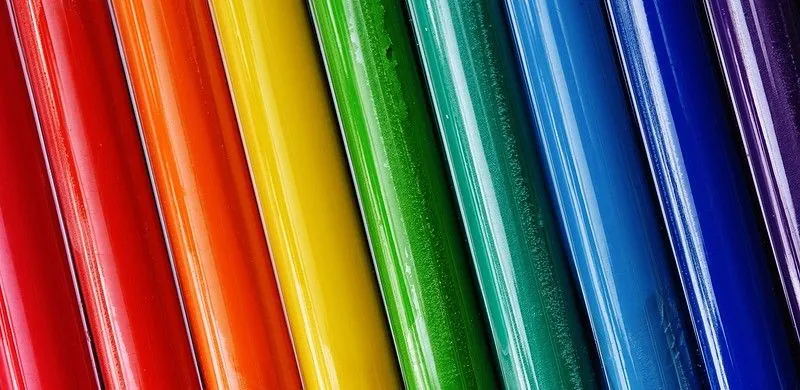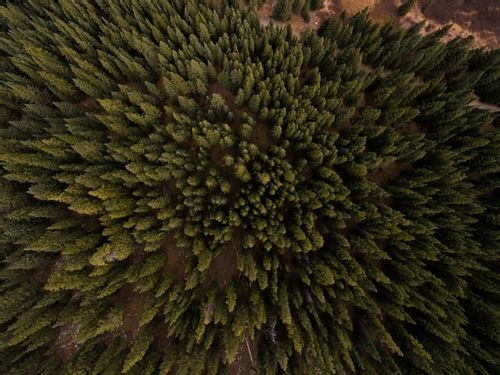FOR ALL AGES
Rainbows were the new black in 2020. You could, and still can, find one in the window of almost every house with children. They’re a big shout of thanks to our NHS healthcare workers, and others on the frontline of the coronavirus struggle.
Rainbows were the new black in 2020. You could, and still can, find one in the window of almost every house with children. They’re a big shout of thanks to our NHS healthcare workers, and others on the frontline of the coronavirus struggle.
But what is a rainbow? Why dow we see seven colours, but never brown? And who was Roy G Biv anyway? Here are seven fascinating facts about rainbows to share with your kids.
Most of us would say that the rainbow contains seven colours (red, orange, yellow, green, blue, indigo and violet). The convention was first proposed by Sir Isaac Newton, who famously split white light into different colours using a prism (the spectrum from light split in this way is actually somewhat different from the separation in a rainbow; the physics can be readily found online). Before Newton, the number was variously 5 or 3, depending on who you asked.
Take a close look at a photo of a rainbow, though, and you’ll see that the colours blur and blend into one another. The change from red to orange, orange to yellow, etc, is not immediate. It’s a rich mix. Every rainbow contains as many hues as you care to name...
...but not all of them. Look though you might, you’ll never spy a true pink in the rainbow. Nor a brown. There’s nothing beige about a rainbow. These colours are all blends. They don’t naturally occur as individual colours of light. What do we mean by that? Well, it gets a little complicated. Colours like red, green and yellow can all be pinned to a particular wavelength of light. Pink cannot. Our brains only acknowledge the colour if we’re seeing a mix of red and violet wavelengths. As these two colours are at opposite ends of the rainbow, they don’t blend together in the sky, and we don’t see any pink. Brown -- as a mix of red and green -- is also absent. All that said, a rare phenomenon known as a pink rainbow is known to science. In fact, I witnessed one over London recently. Pink rainbows occur only at dawn or dusk, when the ambient light is much redder than during the full daylight.
No two people observe the same rainbow. You might look out over a park and see somebody who appears to be standing close to a rainbow, but they won’t see it. Their own rainbow (if they can see one at all) will appear in the distance from their point of view. Even if you’re standing right next to a friend, the light entering their eyes will have been scattered by different raindrops to the light entering your eyes. Every rainbow is exclusive to the person viewing it.
This is one of several reasons that you’ll never find a pot of gold at the end of the rainbow. Like a shadow, the location of the rainbow you see depends on where you’re standing. Attempt to get closer, and the rainbow will retreat.
Rainbows can be circles. It’s true. When we observe from the ground, or even a tower block, we typically only see the upper arc. We’re too close to the ground for the underpart of the rainbow to emerge. But if we get really high up, in an aeroplane or on a mountain, then there may be enough water droplets down below for us to see a complete, circular rainbow. It’s a rare sight, but photos and videos can be found online.

Image: Lauri Kosonen, creative commons licence
It’s quite common to see a double rainbow. The second bow is always fainter, and inverted. Why? If the main rainbow is caused by light reflecting off raindrops, then the secondary rainbow is formed by light that’s bounced around inside the raindrop before reflecting out again. It’s a reflection of a reflection (with a healthy dose of refraction, too) and so is both weaker and a mirror image of the first. Triple and even quadruple rainbows have also been observed, though these are very rare.
We may only glimpse a rainbow every couple of months or so, but they’ve played an enormous role in human culture -- from the Bifrost rainbow bridge of Norse mythology (later woven into the Marvel Cinematic Universe), to Judy Garland’s gateway to Oz, and the psychedelic art of the 1960s. Rainbows are associated with both leprechauns and unicorns (who apparently now poop them). The rainbow flag has become the widely recognised emblem of gay pride and LGBT communities. Most recently, the rainbow has been used as a symbol of support and appreciation for the workers of Britain’s National Health Service. It is almost always a symbol of positivity.
Why not contribute to rainbow culture with one of these 11 crafty ideas? Or these 7 rainbow baking ideas?

Most of us use a mnemonic to remember the order of the rainbow. The two most common are “Richard of York Gave Battle in Vein” and Roy G. Biv (not an actual individual, though I’ve always imagined Mr Biv as a US military man, for some reason).
Why not have fun making up your own mnemonic. How about “Rhinos Or Yaks? Great Beasts I’ll Visit”, or “Really Old Yetis Get Better In Venice”?
Read The Disclaimer
At Kidadl we pride ourselves on offering families original ideas to make the most of time spent together at home or out and about, wherever you are in the world. We strive to recommend the very best things that are suggested by our community and are things we would do ourselves - our aim is to be the trusted friend to parents.
We try our very best, but cannot guarantee perfection. We will always aim to give you accurate information at the date of publication - however, information does change, so it’s important you do your own research, double-check and make the decision that is right for your family.
Kidadl provides inspiration to entertain and educate your children. We recognise that not all activities and ideas are appropriate and suitable for all children and families or in all circumstances. Our recommended activities are based on age but these are a guide. We recommend that these ideas are used as inspiration, that ideas are undertaken with appropriate adult supervision, and that each adult uses their own discretion and knowledge of their children to consider the safety and suitability.
Kidadl cannot accept liability for the execution of these ideas, and parental supervision is advised at all times, as safety is paramount. Anyone using the information provided by Kidadl does so at their own risk and we can not accept liability if things go wrong.
Kidadl is independent and to make our service free to you the reader we are supported by advertising.
We hope you love our recommendations for products and services! What we suggest is selected independently by the Kidadl team. If you purchase using the buy now button we may earn a small commission. This does not influence our choices. Please note: prices are correct and items are available at the time the article was published.
Kidadl has a number of affiliate partners that we work with including Amazon. Please note that Kidadl is a participant in the Amazon Services LLC Associates Program, an affiliate advertising program designed to provide a means for sites to earn advertising fees by advertising and linking to amazon.
We also link to other websites, but are not responsible for their content.
Was this article helpful?



Browse Category



We’ll send you tons of inspiration to help you find a hidden gem in your local area or plan a big day out.



Check your inbox for your latest news from us. You have subscribed to:
Remember that you can always manage your preferences or unsubscribe through the link at the foot of each newsletter.